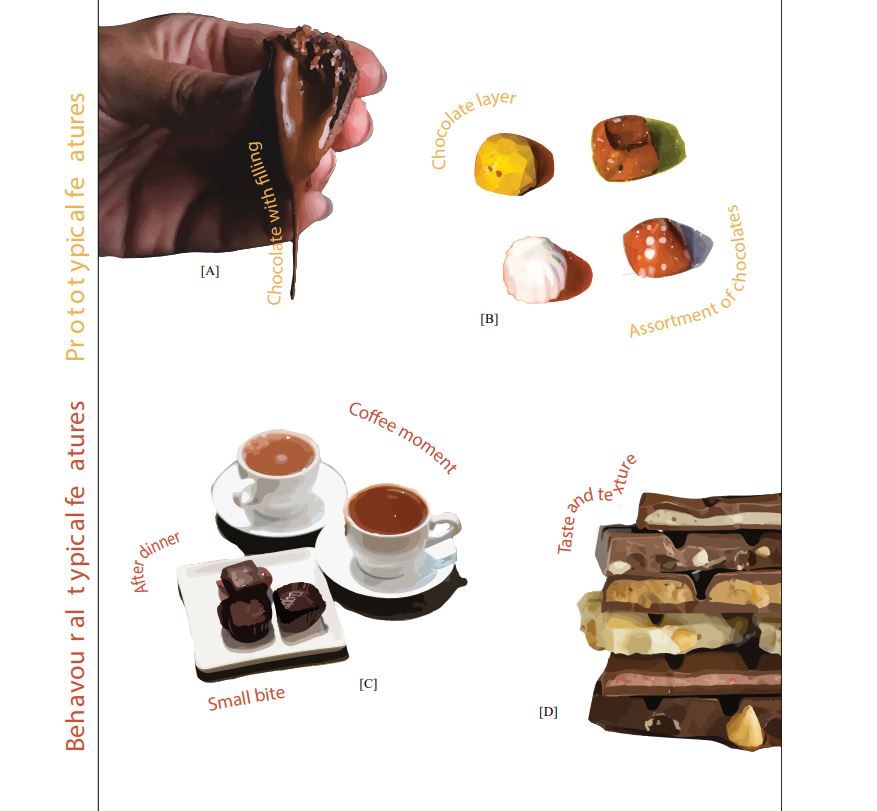
My first year (pre-master and M1.1) at the TU/e was mainly orientational since I was introduced to academia, terminologies, and work around in the department. I became inspired by explorations with materials, and food projects, although I wondered whether I could get involved with this due to my severe nut allergy. As a designer, I first approached the problem from a first-person perspective and used my severe tree nut allergy to understand better the problems I experience daily.
My identity and vision have been developed after discussing the problems and issues with experts and stakeholders. As well as using four core competencies (described on the right), this has been incorporated as much as possible into my projects and courses since my M1.2 semester. The explanation, link to user expertise areas, and examples follow in more detail after this part.
After all, I am glad about the decision to continue my studies; it has helped me understand my preferences and identity as a designer. I have learned what my strengths are and where I gain energy. An important lesson has been that you can dream big and achieve these ambitions as long as you make a plan, are not afraid to fail, and do not postpone any tasks. But use trial and error to examine if things work; in my graduation project, there were many explorations, and I learned a lot by doing. Reflecting on the learnings of my projects and courses helped me achieve the project’s final results.
- Context description: I gathered Knowledge and expertise to describe the context and translate the social impact of food allergy, including user food allergy, 3D printing, textures, and qualities into other materials and concepts that do not contain a (specific) allergen.
- Design for food allergies: I delved into allergens and allergic reactions to understand the effects and why users fear tasting something they don’t know. Also delved into how I could solve that problem by exploring shape, taste, 3D printing, and communication.
- Understanding the value: Understanding the value and business angle of 3D printing in Inclusive Gastronomy Design. It is essential to point out that within society, people with food allergies are a vulnerable, non-dominant group with traumatic experiences. The customer journey of the focus group addressed that there is a lot to gain from improving the restaurant experience. Furthermore, several stakeholders and participants have been interested in helping with the project. Consequently, I am interested in continuing the project after graduation.
- Searching for solutions: To understand what is appropriate by engaging in conversations about my vision and identity with people in my network, chefs from restaurants where I have worked, a business developer friend, and friends with food allergies. As well as interviews with stakeholders and chefs through developing a customer journey for an allergen-free meal. Similar is the search for suitable materials and technologies; this is where my technological knowledge was further developed, orienting me to AI and 3D food printing.
Integration expertise areas on core competencies

- Integration of Creativity and Aesthetics
For me, engaging in aesthetics is about what behaviors you can elicit, such as preparing food separately during gourmet meals or eliciting the affordance to break something. Within my projects, aesthetics are often about communicating something. For example, how to communicate that the food is nut free is 3D printed. This expertise also translates into the experience I want to offer the user through creative solutions.
- Integration of User and Society
Visualizing the experience for people with food allergies was essential to get the message across. The customer journey shows that when it comes to food allergies, the experience is very harmful. The impact on people with food allergies is enormous; therefore, I wanted to map the social problem from the user perspective and validate the hypotheses with user research.
- Integration of Business and Entrepreneurship
Co-creation can contribute to complex societal challenges, where ethics, values, and relationships between humans and the environment are considered. I have often worked with mixed perspectives to correctly identify the issues and understand the value for all stakeholders. For this, I have incorporated my own experiences as a designer and am open to discussions from 2nd and 3rd person perspectives.
For example, for the course DDM150, I worked with a group for Philips to make the waiting room more user-friendly. The emergency room in America is dynamic, and the staff is under pressure. While they are focused on providing the proper care, some patients need help understanding why they must wait so long, so we wanted to split up the patients and provide them with more information. Our concept won the design challenge, and we presented it inside Philips.
To advance to designing a total concept with different stakeholders, I first learned the theory about multi-stakeholder networks, value propositions, and value flow models. In the food projects, I tried to create project value for the stakeholders and understand how they create value for the project.
- Integration of Math, Data, and Computing
For me, integration in my projects is about what you can do with a lot of data and how to analyze it. In my projects, I have often used inductive and deductive Thematic analysis because it helped me find themes within a lot of qualitative data.
Integration alone also represents for me an understanding of what can be digested by AI in the future and what data is suitable for that, so you can apply k-nearest neighbors, for example.
- Integration of Technology and Realization
For using technologies, you have to make critical trade-offs between the added value it gives. As a designer, I ask myself at what point the 3D food printer will be good enough to accommodate food allergies, but I believe you need to test this. Similarly, AI collaboration was a quest in the beginning. However, we discovered that AI collaboration is unnecessary and that an AI that gives a chef suggestions will suffice.





